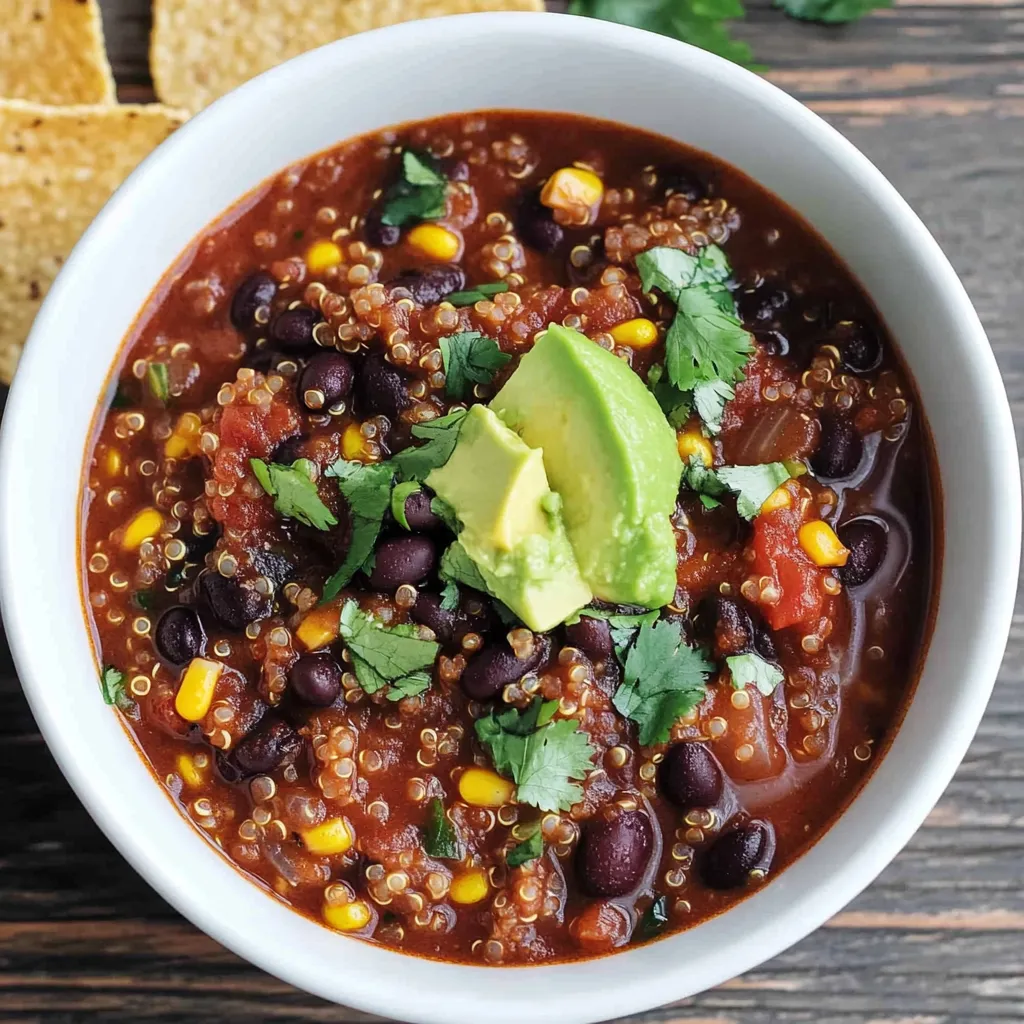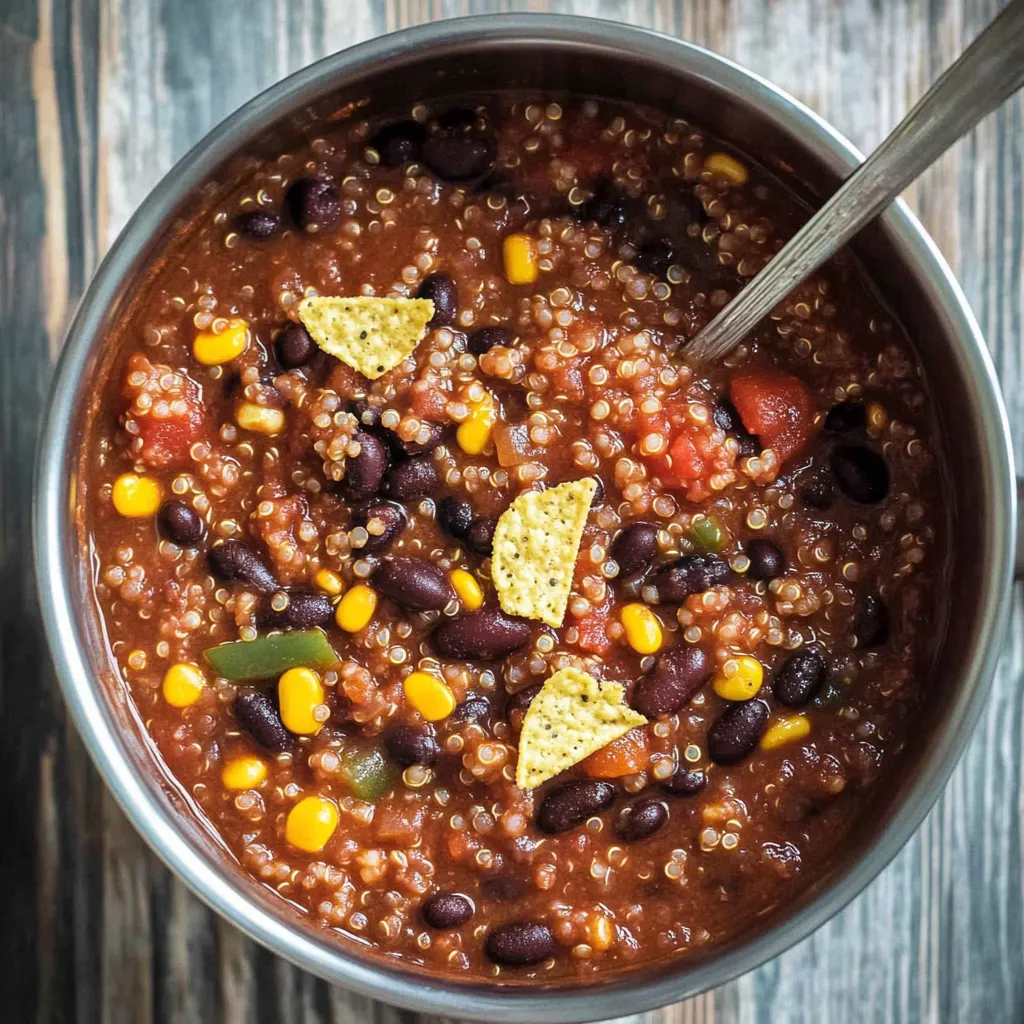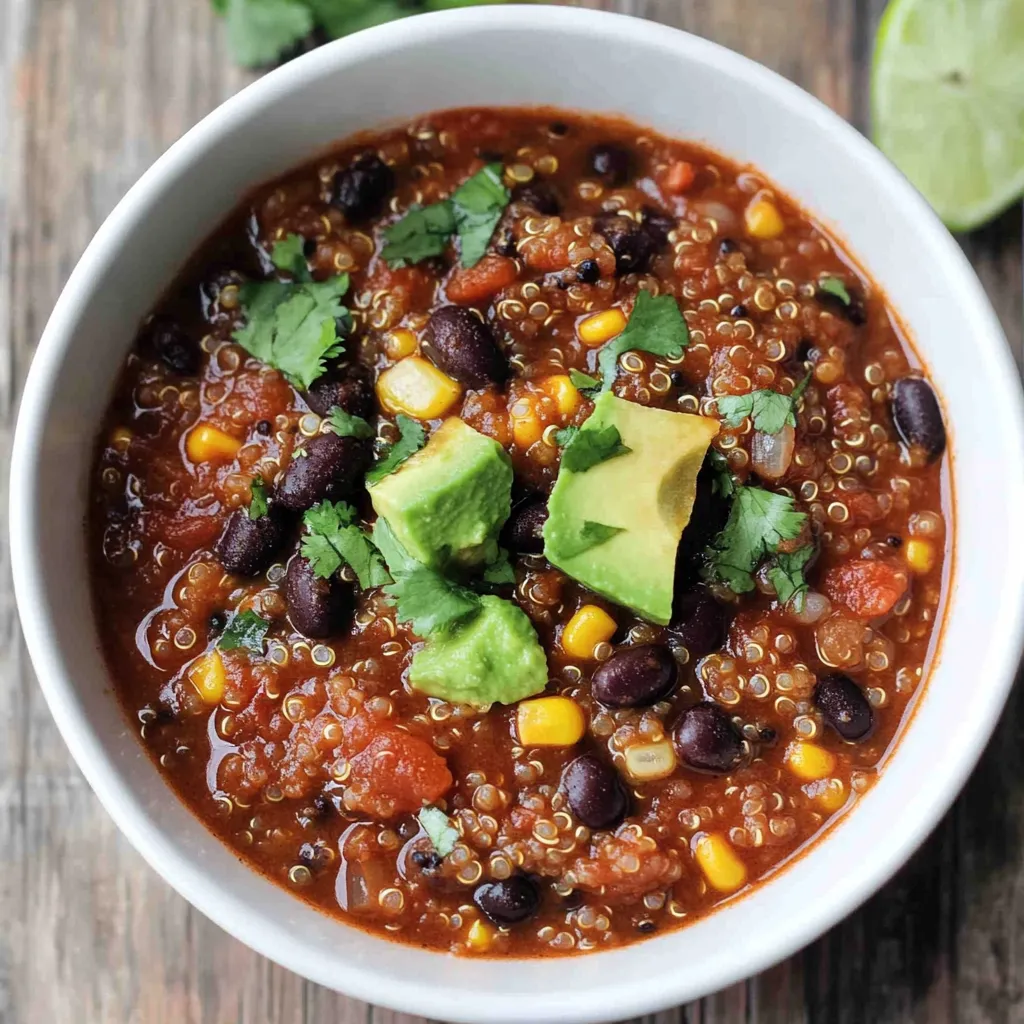 Pin it
Pin it
Simmering black beans and quinoa with vegetables and spices creates a hearty vegan chili that satisfies without any meat. The quinoa cooks directly in the pot alongside everything else, absorbing all those chili flavors while adding protein and making the dish more filling. A surprising splash of cocoa powder adds depth that balances the sweet tomatoes and vegetables without tasting like chocolate. This one-pot meal comes together in under an hour using mostly pantry staples, making it perfect for busy weeknights when you need something warming and substantial.
Vegan chili became my go-to meatless meal after discovering that quinoa makes it substantial enough that nobody asks where the meat is. I was skeptical about adding cocoa powder until trying it once and realizing it creates complexity that regular chili lacks. The bitterness balances all that tomato sweetness perfectly without making anything taste chocolatey. My kids think eating "chocolate chili" is hilarious and devour this without realizing they're eating something healthy and plant-based. Now I make double batches and freeze portions for quick lunches and easy dinners.
Ingredients and Why They Matter
- Canned black beans (2 cans, 15 ounces each, drained and rinsed): Convenient protein and fiber source; pinto or kidney beans substitute
- White quinoa (¾ cup, rinsed well): Adds protein and creates heartier texture than beans alone; tricolor quinoa works too
- Bell peppers (2, any color, diced): Sweet flavor that balances spices
- Carrots (2 medium, shredded): Natural sweetness and nutrients; pre-shredded saves time
- Corn (1½ cups, fresh, frozen, or canned): Sweetness and pop of texture
- Yellow onion (1 large, diced): Aromatic base that sweetens during cooking
- Garlic (4 cloves, minced): Essential aromatic depth
- Diced tomatoes (1 can, 28 ounces with juice): Tomato base for the chili
- Vegetable broth (3 cups): Cooking liquid; water works but broth adds more flavor
- Unsweetened cocoa powder (2 tablespoons): Secret ingredient that adds depth; espresso or dark chocolate substitute
- Chili powder (2 tablespoons): Main spice that defines chili flavor
- Ground cumin (1 tablespoon): Earthy, warm spice essential to chili
- Smoked paprika (1 teaspoon): Adds smoky depth
- Oregano (1 teaspoon dried): Herbal notes
- Salt and black pepper (to taste): Essential for proper seasoning
- Olive oil (2 tablespoons): For sautéing vegetables
How To Make It
- Sauté the aromatics:
- Heat the olive oil in a large pot or Dutch oven over medium heat. Add the diced onion and bell peppers. Cook, stirring occasionally, for about 5-7 minutes until the onion turns translucent and the vegetables soften considerably. The onion should start taking on some golden color around the edges. This initial cooking develops sweetness and creates the flavor foundation for your chili. Don't rush this step by using high heat because you want gentle softening, not charring.
- Add carrots and spices:
- Stir in the shredded carrots along with all your spices - the chili powder, cumin, smoked paprika, oregano, and cocoa powder. Add the minced garlic too. Stir everything together constantly for about 1-2 minutes. You'll notice the spices becoming very fragrant as their essential oils release from the heat. This toasting process is crucial because it wakes up the spices and eliminates any raw, dusty flavor they might have. The vegetables should be well-coated with the spice mixture and everything should smell amazing.
- Add beans, quinoa, and liquids:
- Pour in the drained and rinsed black beans, the rinsed quinoa, the can of diced tomatoes with all their juice, and the vegetable broth. Stir everything together thoroughly, making sure the quinoa isn't clumped and everything is evenly distributed. The mixture will look quite liquidy at this point, which is normal - the quinoa will absorb a lot of liquid as it cooks. Scrape the bottom of the pot to make sure nothing is sticking.
- Simmer covered:
- Increase the heat to bring the chili to a boil, then immediately reduce to low heat. Cover the pot with a lid - this is important because the steam helps cook the quinoa properly and prevents too much liquid from evaporating. Simmer gently for about 20-25 minutes, stirring occasionally to prevent sticking. The quinoa is done when you can see the little spiral-shaped germ separating from each grain and everything is tender. The chili will thicken considerably as the quinoa absorbs liquid.
- Add corn and finish:
- Once the quinoa is tender, stir in the corn. If using frozen corn, it will thaw and heat through in just a minute or two. If using canned, drain it first. Cook for another 2-3 minutes until the corn is heated through. Taste the chili and adjust seasoning - you'll almost certainly need to add more salt, and you might want more chili powder, cumin, or a splash of vinegar or lime juice for brightness. The chili should be thick and hearty, not soupy. If it's too thick, add more broth or water a little at a time until you reach desired consistency.
- Serve with toppings:
- Ladle the hot chili into bowls and let everyone add their favorite toppings. Good options include diced avocado, fresh cilantro, sliced scallions, vegan sour cream, lime wedges, hot sauce, or tortilla chips. Serve immediately while hot, or let it cool slightly if you prefer. The chili is even better the next day after all the flavors have had time to marry in the refrigerator.
 Pin it
Pin it
Cocoa powder in chili sounds strange until you understand its purpose. Traditional meat chili uses cocoa to balance the richness of fat from meat. In this vegan version, it balances the natural sweetness from tomatoes, carrots, and corn instead. The bitterness cuts through sweetness and creates complexity that makes the chili taste more interesting and developed. Using unsweetened cocoa is crucial - sweetened cocoa or chocolate would make it taste dessert-like. A square or two of dark chocolate works similarly, melting into the chili as it cooks.
Quinoa in Chili
Adding quinoa to chili serves multiple purposes beyond just bulking it up. The grain absorbs the cooking liquid and all those spice flavors, becoming seasoned throughout rather than tasting bland. It provides complete protein with all nine essential amino acids, making this chili nutritionally substantial. The texture adds heartiness that makes the dish more satisfying and filling. Quinoa cooks in about 20 minutes when simmered in liquid, making it faster than dried beans. White quinoa has the mildest flavor and softest texture, while red and black quinoa stay firmer with nuttier taste.
The One-Pot Method
Cooking everything in a single pot isn't just convenient - it actually improves flavor. As you sauté vegetables, they release moisture and caramelize slightly, creating fond on the pot bottom. Adding liquid and scraping that fond incorporates concentrated flavor into the dish. Each ingredient added builds on the previous layer. The beans, quinoa, and vegetables all simmer together in the same flavorful broth, allowing flavors to meld and permeate everything. One-pot cooking also means fewer dishes to wash and simpler meal prep.
Spice Blend Balance
The combination of spices creates chili's characteristic flavor profile. Chili powder provides the base flavor with dried chiles and other spices. Cumin adds earthy warmth that's essential to chili. Smoked paprika contributes smoky depth without needing to add liquid smoke. Oregano brings herbal notes. Cocoa adds bitterness and complexity. Together, these create layered flavor that's more interesting than any single spice could provide. You can adjust amounts based on preference - more chili powder for heat, more cumin for earthiness, more smoked paprika for smokiness.
Thickening and Thinning
Chili consistency varies based on personal preference and how much liquid evaporates during cooking. If your chili is too thin, simmer uncovered for 10-15 minutes to evaporate excess liquid. Mash some of the beans with a potato masher to release their starch, which thickens naturally. Add more beans or vegetables. If it's too thick, thin with vegetable broth, water, or even tomato juice, adding gradually and stirring well. The quinoa will continue absorbing liquid as the chili sits, so something perfect today might be too thick tomorrow - just thin it when reheating.
Flavor Boosters
If finished chili tastes flat or one-dimensional, several additions can elevate it. Squeeze fresh lime juice over individual bowls for brightness. Add a splash of red wine or balsamic vinegar for acidity and depth. Stir in a spoonful of tamari or soy sauce for umami and saltiness. Another square of dark chocolate adds richness. Fresh cilantro brings herbaceous freshness. Hot sauce provides heat and tang. Diced fresh onion or scallions add crisp contrast. Sometimes the toppings transform good chili into great chili.
Storage and Meal Prep
Chili is one of the best make-ahead meals because it keeps well and often improves with time. Store cooled chili in airtight containers refrigerated for 4-5 days. The quinoa will absorb more liquid, making it thicker - thin with broth or water when reheating. Freeze in portion-sized containers or freezer bags for 2-3 months. Freeze flat in bags for easier storage and faster thawing. Thaw overnight in the refrigerator before reheating. Reheat gently on the stovetop over medium heat, stirring occasionally and adding liquid as needed. Taste and adjust seasoning after reheating because flavors can dull slightly.
Serving Suggestions
While chili is a complete meal on its own, simple sides enhance the experience. Serve with cornbread, tortilla chips, or crusty bread for dipping. Top with traditional chili garnishes like shredded cheese (or vegan cheese), sour cream (or cashew cream), diced avocado, sliced jalapeños, chopped cilantro, diced red onion, or lime wedges. Serve over baked potatoes or sweet potatoes for loaded potato-chili mashup. Use as filling for tacos or burritos. Pour over rice or quinoa for extra substance. Make chili dogs using veggie dogs and buns. The versatility makes leftovers exciting rather than boring.
 Pin it
Pin it
This black bean quinoa chili represents the kind of plant-based cooking that satisfies everyone, not just vegans or vegetarians. The combination of protein-rich beans and quinoa, flavorful spices, and hearty vegetables creates something substantial enough to be a complete meal. When you serve this and nobody asks where the meat is, you know the recipe succeeds on its own merits rather than as a compromise. Sometimes the best recipes are the ones that prove healthy, plant-based meals can taste just as satisfying as their meat-based counterparts, and this chili definitely accomplishes that goal perfectly every single time you make it.
Frequently Asked Questions
- → Can I make this chili ahead of time?
- Yes, this chili actually tastes better the next day. Store it in the fridge for up to 5 days and reheat on the stove or microwave when ready to eat.
- → Can I freeze black bean quinoa chili?
- Absolutely! Let it cool completely, then freeze in portions for up to 3 months. Thaw overnight in the fridge before reheating.
- → Why does the recipe call for cocoa powder?
- Cocoa powder adds a rich, deep flavor without making the chili sweet. It's a classic trick in chili recipes that brings everything together beautifully.
- → Can I use a different type of bean?
- Sure! Kidney beans, pinto beans, or a mix of beans work great. Just keep the total amount around 4 cups of cooked beans.
- → What if I don't have liquid smoke?
- You can leave it out or add a bit more smoked paprika instead. The chili will still be delicious, just with a slightly different smoky note.
- → How do I keep the quinoa from getting mushy?
- Make sure to rinse the quinoa well and don't overcook it. Simmer for just 15 minutes with the lid on, and it should come out perfect every time.
- → Can I use red or black quinoa instead of white?
- Yes, but keep in mind that red and black quinoa take a bit longer to cook. You might need to add 5 extra minutes of simmering time.
